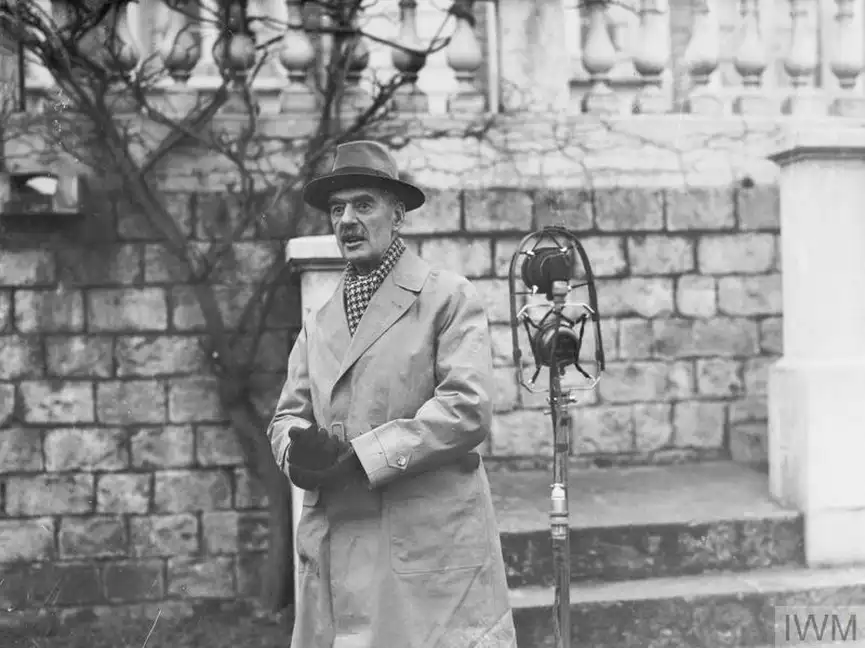Encyclopedia
Luis Salgado
What is the Munich Agreement?
- Germany, the United Kingdom, France, and Italy signed the Munich Agreement, allowing Nazi Germany to annex the Sudetenland region to the west of Czechoslovakia.

In 1938 Neville Chamberlain proclaimed “This is peace for our time” after Germany, the UK, France and Italy signed the Munich Agreement – allowing Nazi Germany to annex the Sudetenland region to western Czechoslovakia.
The Sudetenland area contained around three million people of German origin and in May 1938 it became known that Hitler and his generals planned to occupy the region. The Czechoslovak government hoped that Britain and France would come to their aid in the event of an invasion, but British Prime Minister Neville Chamberlain was intent on avoiding war.
Between September 15 and 30, Chamberlain made three trips to Germany to see Hitler. The last of these trips, in Munich, resulted in large swaths of Czechoslovakia coming under Nazi rule. Britain and France would not support any Czech resistance.
Returning from Munich, Chamberlain told an excited crowd at Heston airport: "It is peace for our time," and waved at the agreement he had signed with Hitler. This was the high point of his appeasement policy. Six months later, Hitler reneged on his promises and ordered his armies to march on Prague. Within a year, Britain and France were at war with Germany.
How was the Munich Agreement developed?
On September 12, 1938, Hitler delivered a speech in which he condemned the actions of the Czechoslovak government. In it, Hitler argued that the country was made up of people of different nationalities, but that it was the Czechs who enjoyed a hegemony that threatened the self-determination of the peoples, since the Germans in Czechoslovak territory had the right to reunify with the people. German.
Such words predicted conflict and for this reason, the following day, the British Prime Minister – Neville Chamberlain – requested a personal meeting with Hitler, which would take place on September 15 in the city of Berchtesgaden. At such a meeting Hitler made clear his intentions that German residents of the Sudetenland region be allowed to reunify with Germany.
The next day, French Prime Minister Édouard Daladier traveled to London for talks with the British government. An action plan arose from such a meeting that considered asking Czechoslovakia to cede to Germany all territories where the German population exceeded 50% of the total. Such a proposal was rejected by both Czechoslovakia.
The next day, September 17, Hitler ordered the creation of the Sudeten German Volunteer Corps (Sudetendeutsches Freikorps). Paramilitary organization that began acts of aggression and “terrorism” on Czechoslovak territory.
On September 22 Chamberlain flew to Cologne, Germany to meet Hitler again. There he informed Hitler about the "agreement" of the West to cede the Sudetenland to Germany, a proposal that was refused by Hitler who reported that since their last meeting the situation in Czechoslovakia was unacceptable due to the murders of Germans that had taken place. the last days. However, later that same day the two agreed to surrender the Sudetenland.
On September 24, Hitler issued the Godesberg ultimatum which stipulated that the Sudetenland should be handed over to Germany and set a deadline of September 28 at 2pm sharp. When the date arrived, with a few hours remaining, Mussolini intervened in the situation to extend the ultimatum limit. For this, he contacted the Italian ambassador in Germany and asked Hitler to be informed that in any situation "Italy would be on his side", but that he extend the ultimatum by 24 hours.
Hitler accepted the proposal and a meeting of the 4 powers was called by Chamberlain. Said meeting took place on September 29 and the final agreement would be resolved at dawn on September 30.
The transfer of the Sudetenland to Germany
The agreement was officially presented by Mussolini, although in fact the Italian plan was almost identical to Godesberg's proposal: the German army was to complete the occupation of the Sudetenland by October 10, and an international commission would decide the future of other areas in quarrel. Czechoslovakia was informed by Britain and France that it could either resist Nazi Germany alone or submit to the prescribed annexations. The Czechoslovak government, realizing the hopelessness of fighting the Nazis alone, reluctantly capitulated (30 September) and agreed to honor the agreement.
The agreement gave Germany the Sudetenland from October 10 and de facto control over the rest of Czechoslovakia as long as Hitler promised to go no further. On September 30, after a break, Chamberlain went to Hitler and asked him to sign a peace treaty between the United Kingdom and Germany. After Hitler's interpreter translated it for him, he happily agreed.
On September 30, upon his return to Britain, Chamberlain delivered his controversial "peace for our time" speech to crowds in London.
Hitler's victory
Hitler had gotten exactly what he wanted and without war. His popularity in Germany skyrocketed after this – a great victory. Germany had not only brought more Germans into this Gross Deutsche Reich (a larger German Reich), but Britain, France, and Italy had also come to Germany. Germany, under Hitler, had forged her own destiny.
German troops immediately moved into Czechoslovakia; the Sudetenland became part of Germany. There were no fights. Absent at the Munich Conference were the Czechs, whose delegation literally had to stand outside the building, waiting to hear the fate of their country, the news brought to them with great shame by Britain and France.
The other party not invited to the conference was the Soviet Union, which kept saying throughout the process that it would fulfill its obligations to Czechoslovakia as long as Poland and Hungary allowed the Red Army to pass through their territories.
The Nazi invasion
Three weeks later, military plans for the invasion of what was left of Czechoslovakia were already underway. In other words, Hitler would not be satisfied with just the Sudetenland. In March 1939, Germany invaded the rude state of Czechoslovakia.
Up to this point, all of Hitler's foreign policy moves (remilitarization of the Rhineland, German territory, the Anschluss with Austria, the Sudetenland with its largely ethnic German population) could be justified under the principle of national self-determination of peoples. But when, in March 1939, German troops crossed the border, the situation was inexcusable even under the shades of the British appeasement policy.
Faced with the invasion, the Czech government was in an impossible position. There was no real resistance to the advance of the Third Reich. However, there were consequences of this German invasion. England now made a compromise with the Polish state, which could logically be next in Hitler's plan, a guarantee of Polish sovereignty.
The French also promised a similar stance in case the Polish borders were to come face to face with Nazi military might. The question was, would they honor that promise with the Poles? After all, they had not defended the Czechoslovak population despite being the “great western powers”.
History would prove right those who have believed in the support promised by France and the United Kingdom, since 2 days after the German invasion of Poland both countries would declare war on the Third Reich – thus beginning the Second World War.
Takeaway Questions
When and where did the European leaders meet for the Munich Conference? On September 29, 1938, Neville Chamberlain, Edouard Daladier of France, Mussolini, and Hitler met at the Führerbau, the Führer's offices in Munich, for the Munich Conference. When did Hitler invade Czechoslovakia? Hitler invaded Czechoslovakia in March 1939, a few months after the annexation of the Sudetenland. What were the implications for the Czechs under the Munich Pact? After the signing of the Munich Pact, German troops immediately moved into Czechoslovakia; the Sudetenland became part of Germany. The Czechs had to quietly agree to this move.
Sources
SIN FUENTES

